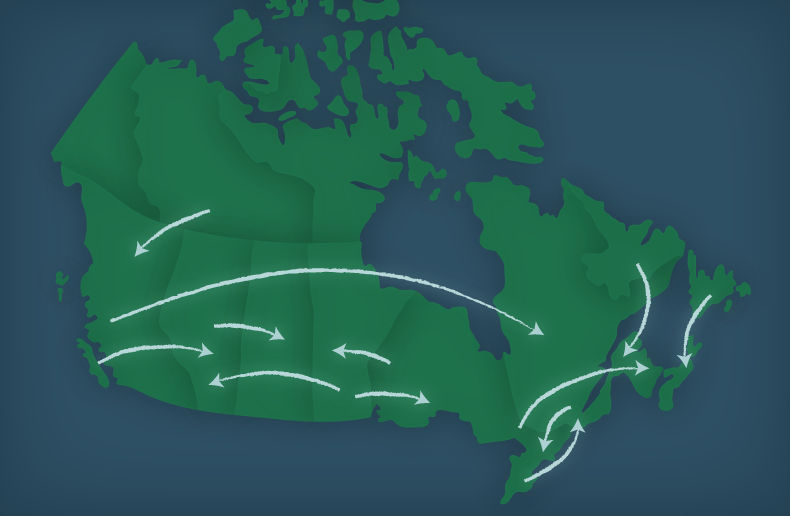Segregated fund contracts with a guaranteed minimum withdrawal benefit are storming the market. Manulife Investments launched the first such product in Canada in October 2006 with great success and now a number of other players are positioning themselves to take a slice of the pie.
Sun Life Financial followed Manulife by launching its own product in April 2007 and Desjardins Financial Security (DFS) joined the party just weeks ago. At press time, Industrial Alliance was poised to release its own product on Dec. 3.
Although funds with a guaranteed minimum withdrawal benefit (GMWB) tend to be pricey, investors are enamoured with this product, which Manulife imported from the U.S. in 2006.
In five years, the product gleaned over $400 billion in sales in the U.S., an interactive presentation on Sun Life’s website reveals. In Canada, the insurer expects this market to grow by billions of dollars in the coming years.
The first tangible proof of its popularity in Canada: Manulife racked up $2.5 billion in assets in a little over a year with its IncomePlus product.Sun Life, however, is keeping its results under wraps. Second to enter this market, the insurer says it is very pleased with the results since the fund was launched this past spring. Vice-president individual wealth management Peter Glaab, sums up the sales of SunWise Elite Plus as "significant."
However, in its third quarter 2007 results, Sun Life announced that individual segregated fund sales in Canada including deposits from the Sunwise Elite Plus GMWB were up 75% to $446 million compared to the same period in 2006.
Desjardins launched its product, Helios, in late October and hopes to realize at least $160 million in gross sales in one year. For its brand new product
EcoFlextra, Industrial Alliance’s assistant vice-president, marketing, insurance and individual annuities Jacques Potvin, cites the objective recently set by the president and CEO Yvon Charest: grow five per cent higher than the industry average for each of its products.
Clearly, confidence is contagious in this market, and even consumers are not immune. Clients say: "My advisor doesn’t know the guaranteed minimum withdrawal products. Could you refer me to someone who does?" explains J. Roy Firth, executive vice-president, individual wealth management, Canadian Division Manulife Financial and chairman & CEO, Elliott & Page Limited. "Clients are calling our advisors every day to ask for information about IncomePlus," he says, pointing out that this is unheard of for a financial product.At DSF,
Claude Paré, senior manager, investment product development, observes that this new product has even heated up competition among advisors. "Clients are calling our advisors and saying they were solicited by our competitors’ advisors regarding this product," he says.
Despite its attractive features, some may find the new guarantee too costly. Depending on the segregated funds the client chooses within the Manulife contract, the fees generally range between 3.25% and 3.50%, and may climb to 3.75%, Mr. Firth says. For a typical equity fund with a 2.5% management expense ratio (MER), IncomePlus would require a MER of 3.25%, Mr. Firth explains.
The lower the fund risk, the lower the cost of the guarantee. At DSF, the Canadian balanced fund Fiera costs 2.6%, or 30 basis points (0.30%) more than the version with death and maturity guarantee of 75%. In contrast, the Fidelity Investments global segregated fund costs 85 basis points more than Helios, bringing the MER to 3.80%.
At Industrial Alliance, Mr. Potvin puts the cost at about 80 basis points higher than a segregated fund with a death and maturity guarantee of 75%. Meanwhile, Sun Life describes its costs as competitive, without elaborating.
Longevity risk
Investors are willing to pay such high fees because they consider it worthwhile, the insurers interviewed explained. The GMWB takes direct aim at baby boomers. For investors approaching retirement, it is not the fear of high costs that is top of mind, but rather the fear of outliving their retirement savings (see longevity table).
"We have found a product that addresses the fears of living to age 100," says Mr. Firth of Manulife. He thinks the price is not too much to pay given the peace of mind this type of product procures for people that are receiving, or about to receive retirement income.
This product mitigates three basic but key risks for the investor on the threshold of retirement: longevity, inflation and volatility, explains Mr. Glaab of Sun Life.
Mr. Paré of DSF depicts the product as a defence against the catastrophic risk of seeing the markets plunge in the first years of retirement. Such losses are in fact difficult for retirees to recoup later, he points out. "The message that we send with Helios is that if the market corrects, you do not need to panic, sell or transfer your funds when the market is down," he says.
Mr. Potvin of IA even questions whether the fees are that high. "I’m not certain that the real cost of this guarantee is so high. This guarantee offers retirees that are afraid to see the stock market collapse a chance to make higher performing investments than GICs. The better return they earn offsets these costs."
The players are unanimous that the industry was more than ready for an investment product that focuses on income rather than accumulation of wealth. The demographic trend is unavoidable, they say. "Three million Canadians will be retiring in the next decade," Sun Life’s interactive website reports.
The insurer adds that half of the women and a third of the men that are 65 today will live until age 85 – a compelling argument to justify a GMWB for at least twenty years. In addition, the company projects that even with an inflation rate of 2%, today’s dollar will not be worth more than 60 cents in 20 years.
Manulife launched a media campaign to advertise that it now offers its IncomePlus clients a GMWB for life when they reach age 65. The option is called the Lifetime Withdrawal Amount.
Industrial Alliance has introduced a similar lifetime guarantee starting at age 65.
The more typical guarantee, found at Sun Life, for example, is a GMWB for 20 years. Usually, withdrawals correspond to 5% of the initial capital.
At DFS, Helios offers a GMWB of 7% of the accumulated capital, but for only 14 years (plus a guaranteed withdrawal of 2% in the 15th year).
However, DFS alone reimburses the cost of the guarantee at maturity.
All products reset the market value of the contract a specific number of times during the withdrawal period. If the market returns exceed the guarantee, the added value will result in a longer withdrawal period or in larger withdrawals.
In addition, the products tack on a 5% bonus for each year without withdrawals. For its lifetime withdrawal option, Manulife offers a 5% bonus in each of the first 15 years in which the contract holder does not make a withdrawal. Sun Life provides this guarantee for the first 10 years without a withdrawal, as does Manulife for the version of its product with the 20-year withdrawal period.
Presently, Standard Life Canada does not offer a GMWB, although the insurer launched a new version of its Ideal segregated funds specifically directed at a clientele on the edge of retirement.
Ideal segregated funds let insured access 26 mutual funds and four underlying mutual funds manufactured by Standard Life Investment Funds. The Platinum Option is a reduced fee option, although a minimum deposit of $250,000 is required."The trend is toward consolidation of assets as part of retirement income planning," says
Michel Fortin, vice-president marketing, individual markets at Standard Life. "In this perspective, $250,000 is really the minimum to generate retirement income."
Reduced fees are another characteristic valued by the target market of investors aged 45 and over, Mr. Fortin says. With Ideal funds, the MER varies between 1.95% and 2.05%. For example, basic Canadian equity segregated funds have a MER of 2.4%, while the Platinum Option has a MER of 1.95%. By comparison, American equity funds have a base MER of 2.5% that drops to 2.05% in the Platinum Option.
"People about to retire want the lowest possible fees to ensure the highest retirement income. In short, they want to be able to sleep at night. High costs run counter to our business philosophy. You can have the best manager in the world, but in the end, the fees make all the difference."
Instead of a GMWB, Standard Life offers the Performance Annuity, a lifetime annuity that differs from competing products because it lets annuitants earn variable income from equity returns pegged to five mutual fund indices.
After producing income that falls slightly below the average of the usual lifetime annuities, investors can then transfer a portion of their capital into a new annuity with a higher rate. "It’s a bit like the reset principle for segregated funds."
Mr. Fortin says that there is no silver bullet. "Ideally, advisors should be able to access a set of products that, in combination, will let them meet all their clients’ needs." Also, advisors should review the needs of each client annually, he recommends. The most disciplined players will reap the most assets on the market, he concludes.






